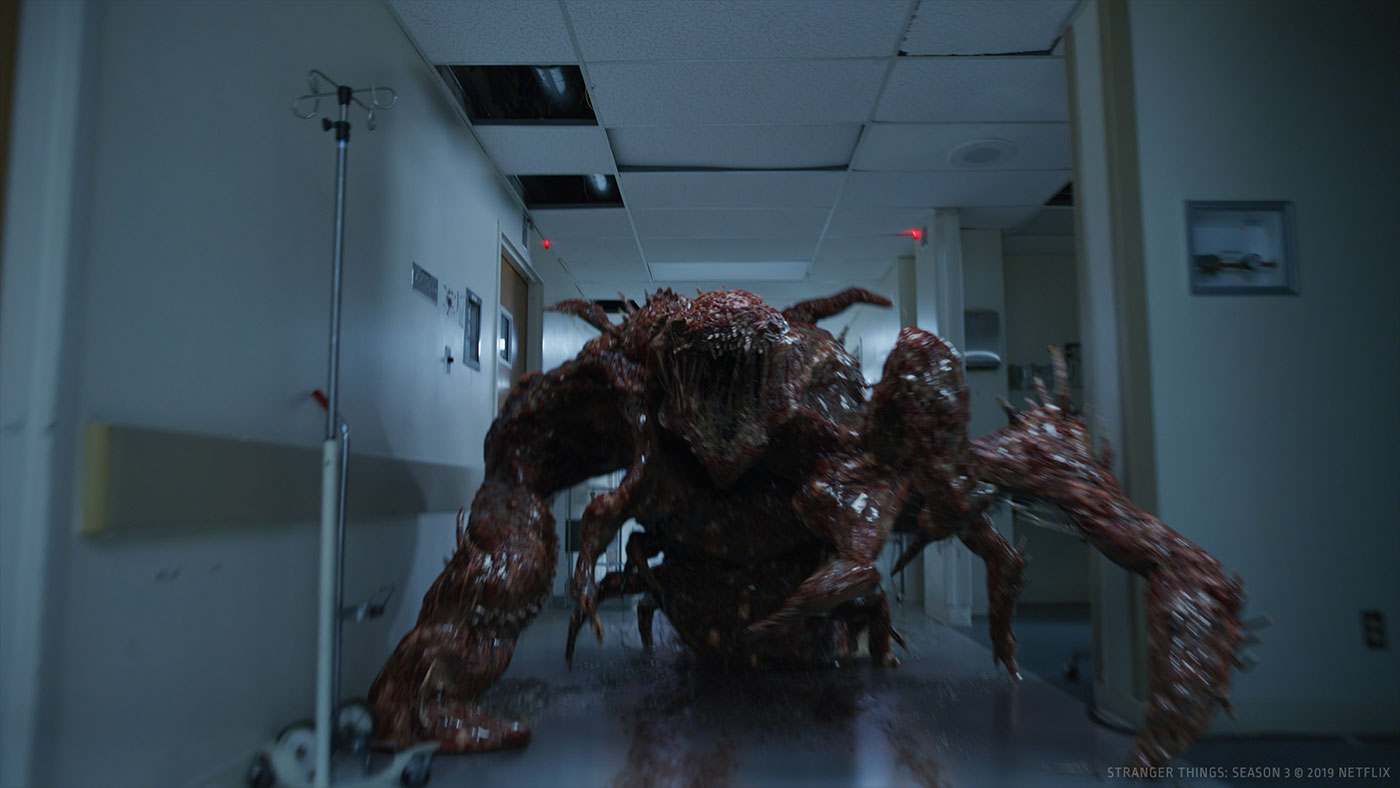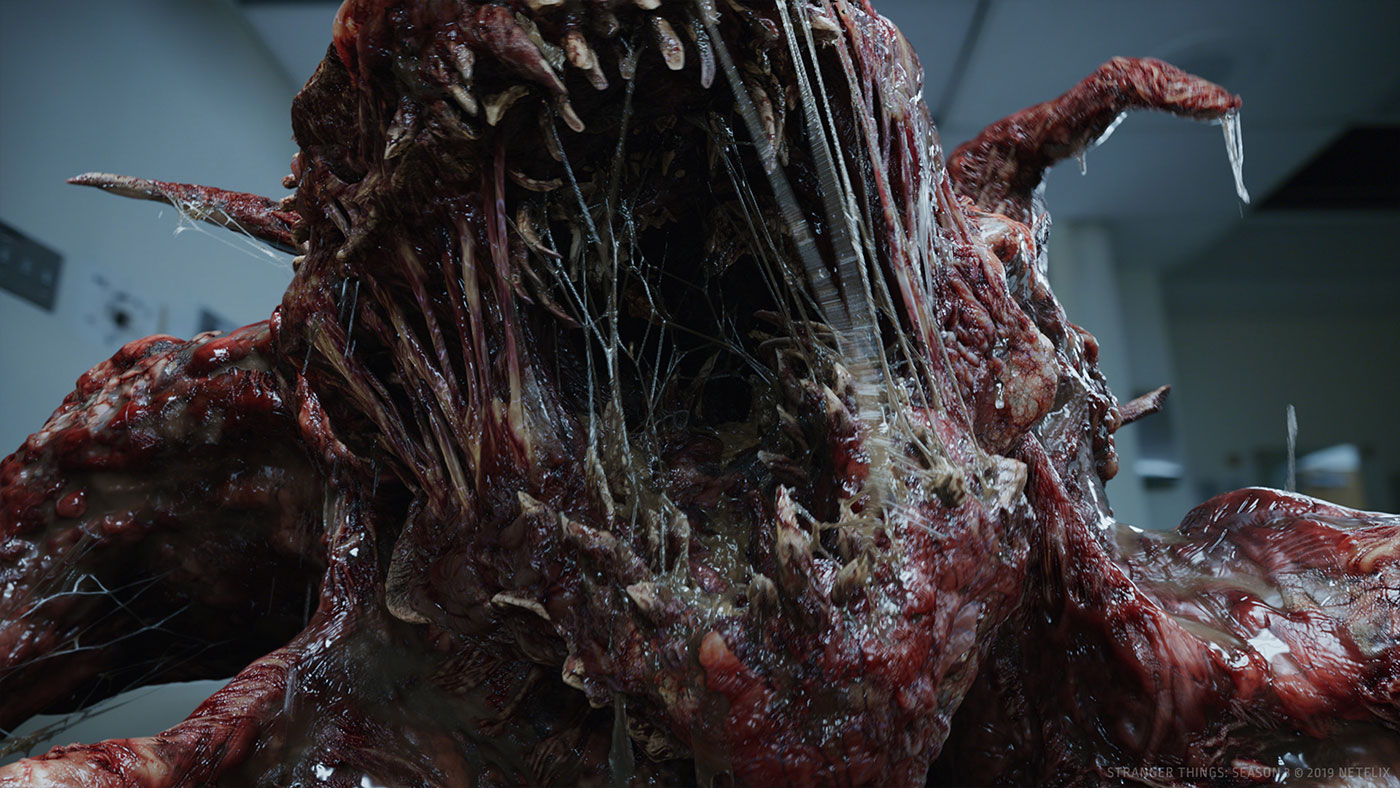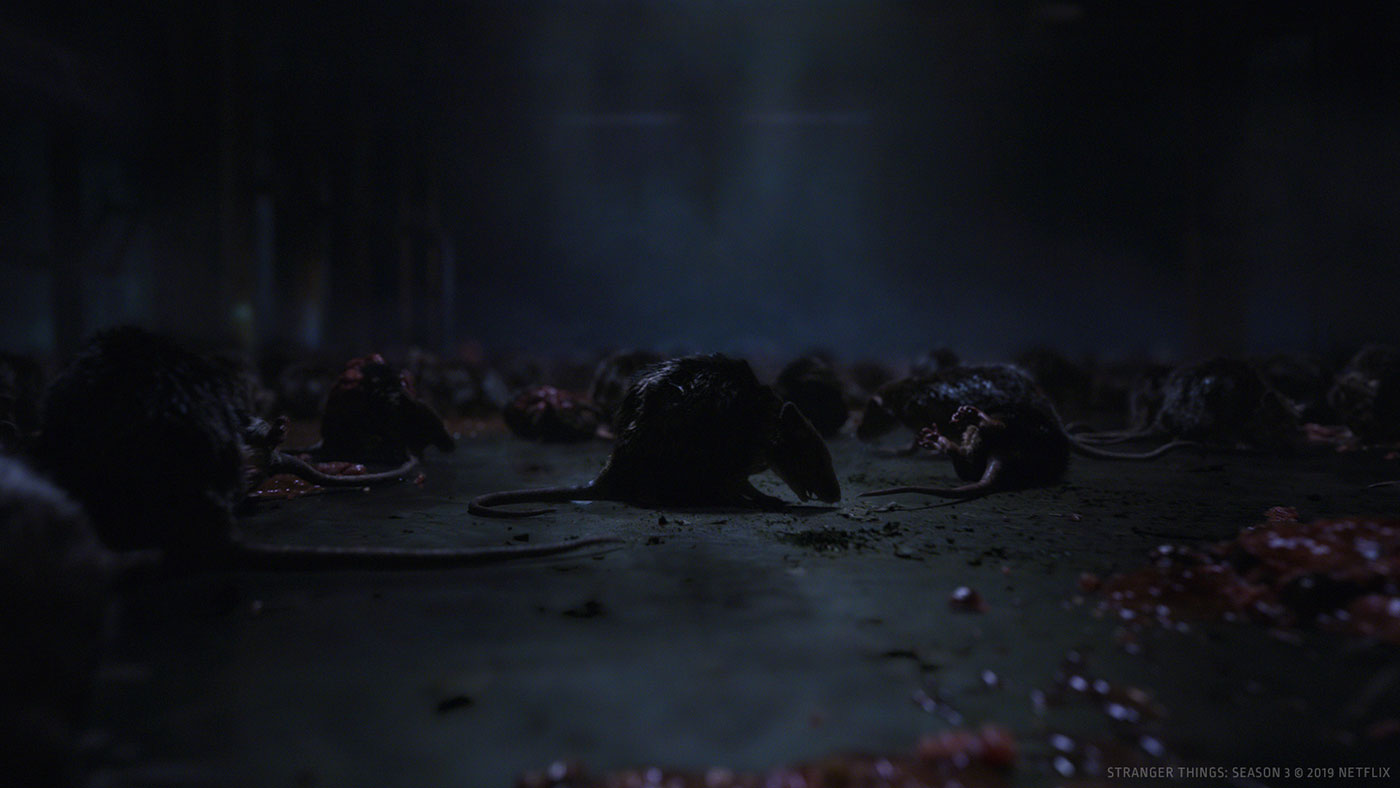In 2012, Martin Pelletier explained the work of Modus FX on MIRROR MIRROR. He joined Rodeo FX in 2014 and became the Head of Studio for their Quebec City office. As a VFX Supervisor, he took care of the effects of projects such as FEAR THE WALKING DEAD, DEATH WISH, KRYPTON and THE WALKING DEAD.
How did you and Rodeo FX get involved on this show?
It all started with a casual meeting with Overall VFX Supervisor Paul Graff, Rodeo FX VP Development and Technology Jordan Soles and myself at our Rodeo FX LA studio. We spent a fun hour talking about history, technology and a little bit about the first two seasons of STRANGER THINGS. The meeting ended with Paul telling us we were ‘cool guys’ and that he would like to have us on board for Season 3. What we didn’t expect was to end up as main vendor!
How was the collaboration with the Duffer Brothers and Overall VFX Supervisor Paul Graff?
A very fun and exhilarating ride from day 1, right up to the end. The Duffer Brothers are genuinely smart and enthusiastic, they are both a perfect blend of cool and clever. They have a clear idea of what they want and expect but they also are very open minded throughout the creative process. As for Paul Graff, he is not only a knowledgeable VFX sup but he is also well aware of the Stranger Things world and intricacies. The whole process has been a pretty smooth ride considering the complexity of the workload.
What were their expectations and approach about the visual effects?
They were looking to raise the bar to another level for Season 3. The initial creative discussions we had were about the many inspirations from the 80’s and some iconic shots from the movie THE THING (original version) and how we could bring that practical slimy wet look into a massive volume of CG monster shots. The other main VFX topic was about the fireworks for the Starcourt battle, wondering if there was any practical options to it or if it would have to be full CG. A few on set tests showed that exposure, size, timing and positioning were nearly impossible to control in any efficient way. During that same period, our team came up with a full CG test using our temp assets and the result was very successful and proved to be the way to go for the final episode.
How did you organize the work with your VFX Producer?
Stranger Things VFX Producer at Rodeo FX, Valerie Clement, happens to be my wife and partner in crime for the last 7 years, so we are a very good fit to run a show. It was as much of a treat and honour for her to work on Season 3 as it was for me. Over the years we have developed a chemistry that brought her to closely understand my role as a VFX sup as much as it lead me to understand her role and challenges as a VFX producer. That helps both the team and ourselves to be more efficient and streamlined and to stay on track the whole time.
How did you split the work amongst the Rodeo FX offices?
The bulk of the work was shared between the Quebec and the Montreal studios. Since the core production team and myself were located in Quebec City, we kept the asset look development here, as well as the key shots in comp to set the overall look. We also had part of the animation team in Quebec. Our Montreal studio, where most of Rodeo’s artists are located, was in charge of most of the animation, lead by Yvon Jardel as our anim supervisor. The lighting department as well as our lead FX were working from there along with a team of compositors. For the Munich Studio, we sent out sequences their way mostly for FX work and compositing.
What are the sequences made by Rodeo FX?
We were responsible for all the shots involving creature work, from the rats exploding into goop to humans melting into the TomBruce monster in the hospital. On top of that, we had the honour to be in charge of developing the fleshy version of the Mind Flayer, the “wet and slimy” spider monster in all its variations as well as the cabin fight with the tentacles. We also did some establishers of the Starcourt mall exteriors, flying over and into the abandoned factory.
How did you work with the art department for The Mind Flayer?
When Rodeo FX jumped on board, some of the ground work and designs were already in place thanks to Micheal Maher, a brilliant artist who works with the Duffer Brothers and Paul Graff as production concept artist and CG generalist. We started to build the main creature assets based on approved designs and conversations about the way it should move and look.
What kind of references and indications did you received for it?
Production provided us with a set of concepts showcasing the Mind Flayer monster in context in the dark basement of the factory as well as a version of the grown up monster inside the Starcourt mall.
Can you elaborate about the creation of The Mind Flayer?
The first step into creating the Mind Flayer monster asset was to establish our approach in regards to the scale that was going to change a lot over the course of the show. We needed our monster to easily scale up and down as a whole, but, more importantly, we had to have control over specific body parts such as feet and legs, shoulders and back but also head size to adjust proportion as he was feeding and growing. As for the textures, our setup was based on a procedural approach allowing us to adapt the details and muscle fiber according to his size fairly easily.
The 2nd step from there was to develop a constant dripping wet look with FX simulation layers. We broke down the setup into 3 main layers, all size adaptable, and optimized the caching and meshing process as much as we could. We also made it visible only within the frustum of the camera to minimize the cache sizes.
How did you create the various shaders and textures?
Even though it wasn’t part of our pipeline yet, we decided to handle all the texture work with Substance designer and Substance painter. Translating the GPU result into Arnold shaders was then fairly straight forward.
Can you tell us more about the rigging and animation?
Rigging was a very important piece of the puzzle in order to get our animators to work fast and iterate quickly. We came up with a multi layered rig system that was allowing animators to load only what was needed for a specific shot. The base rig included controllers to deal with any type of walking, running or whatever movement was required with the legs, body, torso and the head. We also added a system to easily keyframe the muscle bouncing on every step. From there, a second rig was loaded to do facial work on the head and mouth. The Mind Flayer monster was built without any attached tentacles to reduce the weight on one end, and to allow us to add as many tentacles as needed and position them wherever it would work best for the shot.
How does the various sizes of The Mind Flayer affects the animation work?
The rig was built in a way so scaling up and down our monster, proportionally or in specific areas, would be very easy. Animators only had to think about the speed and weight needed to set the scale of the creature once the size was locked.
Can you tell us more about the mouth animation and the tentacles?
As the Mind Flayer monster grows from episode 2 up to the end, we had to come up with a head kit. The smaller version only had a few visible teeth which were covered by black slime, and, as it evolves, the black slime is recessing inside the mouth to finally expose the multiple rows of teeth and broken bones clearly established in episode 7 during the cabin fight sequence. Therefore, we started with a simplified facial/mouth rig and had to adapt it for the last 2 episodes to cover the many close up shots and mouth action.
For the tentacles, we had a few pre production discussions with Paul Graff and the Duffer Brothers to decide whether every monster iteration would have tentacles and if the amount and size would be consistent or not. The decision was made to have the tentacle to be a completely separate asset that could be positioned, scaled and multiplied as many times as we needed depending on the shot and sequence intention. That ended up being a very wise move as it made the animators’ lives much easier and it also made our asset much lighter to deal with.
How did you handle the lighting challenges?
As you have seen throughout the show, the lights are flickering every time the Mind Flayer shows up. While on set, we discussed with the lighting department to see if they could make the flickering rig to cycle back over a short period of time in order to be able to replicate that same cycle on a CG light rig. It turned out they couldn’t, so we decided that the best approach to match the on set lighting was to give that control to compositing using light groups and shadow groups. That way we could minimize bad and costly off sync CG renders.
How was his presence simulated on-set?
From episode 2 up to 6, the Mind Flayer was small enough (9 feet tall) that we could use a good old chrome ball as a target for camera and actors to look at. As for the final Starcourt battle sequence, considering the much bigger size of the Mind Flayer (22 feet tall) and the type of action, we did the full sequence in previz as a guide for shooting, and, to make sure the camera operator could aim at something, I used a 30 foot pole with a huge beach ball strapped at the tip as reference for the Mind Flayer’s head. Pretty old school but very efficient!
Can you explain in detail about the rats creation?
Rats are very common little creatures coming in various types. The Duffer Brothers wanted the rats to look somehow small and inoffensive but also dirty, wet and clumsy. Paul Graff sent us some very nice video references of temple rats found in South East Asia. Our rat asset was built based on these refs with many blend shapes to cover for variations in size and proportions. Once again, we built the rig so we could easily scale our assets if needed without affecting the grooming or anything else.
How did you handle the crowd animation?
Of the whole scope, we only had 6 shots with enough rats to consider crowd simulation. The first shot we started working on was the factory basement establisher with rats going down the stairs into the pit where they start to explode as the camera pulls in. We quickly realized, going into blocking, that crowd was not the way to go for such a shot. It had to be done with key framed hero rats to cover the main action in the foreground and midground while the background was filled with rat clusters of animation cycles. As for the remaining 5 shots, we have used Houdini to create the crowd systems using a mix of typical run cycles.
Can you elaborates about the terrifying explosion of the rats?
That one is surely part of the highlights of what we had to create this season. When the Duffer Brothers came up with that idea in pre-production it was a big moment as the whole goop look evolving and transforming throughout the episodes was a very sensitive subject. We needed to match their vision while also avoiding falling into “gore territory”. The idea behind the rats exploding to create that goop was to make it feel like bloody slimy guts and bones but still making sure it wasn’t too self descriptive and disturbing. We were trying to find that thin line between being too realistic and having it look spooky cool. The whole simulation system was using a library of multiple organic fleshy pieces with various bones. Once all of it was simulated using a volume as container, we had to run a second simulation system to cover the stacked pieces with thick semi transparent slime blending everything together.
Which shot or sequence was the most challenging?
The Tom and Bruce melting process leading to the monster in the hospital, and the melting flayed merging into the Mind Flayer in the factory basement, were the greatest challenges of all. The look had to, once again, remain in the spooky zone without going too gore, which made it tricky to iterate up to an approved look.
The challenge was to maintain a consistent look, shape, size and motion within a sequence with simulation. Ending up with a shot on cut out frame with a great composition and look was hard enough, then we had to make sure the cut in frame of the next shot would start with a close to identical shape and look over 2 or 3 layers of simulations.
Is there something specific that gave you some really short nights?
Considering the type of work we have done, I feel like we handled it very smoothly as a team and I never had to fall into insane overtime and endless days.
What is your favorite shot or sequence?
From a technical point of view, the whole melting sequence leading into the TomBruce monster.
As for my favorite “eye candy” sequence, it has to be the Starcourt battle with the Mind flayer monster attacked with fireworks.
What is your best memory on this show?
It has been an absolute treat from day one up to the end, but if I need to pick one specific moment, it would be the day when we finally cracked the code with the Mind Flayer look dev covered with dripping slime coming to life in a shot.
How long have you worked on this show?
From pre production up to the final shot delivered, we spent close to 14 months on the show.
What’s the VFX shots count?
362 shots.
What was the size of your team?
At the production peak toward the end we had a team of nearly 200 people scattered in our 3 different Rodeo facilities in Quebec City, Montreal and Munich.
What is your next project?
Apart from hoping to be back on Season 4, I have another non-disclosed project in pre production that is keeping me busy and happy. Right now, I’m also enjoying some time off with my third child who was just born this week.
A big thanks for your time.
WANT TO KNOW MORE?
Rodeo FX: Dedicated page about STRANGER THINGS – Season 3 on Rodeo FX website.
© Vincent Frei – The Art of VFX – 2019







